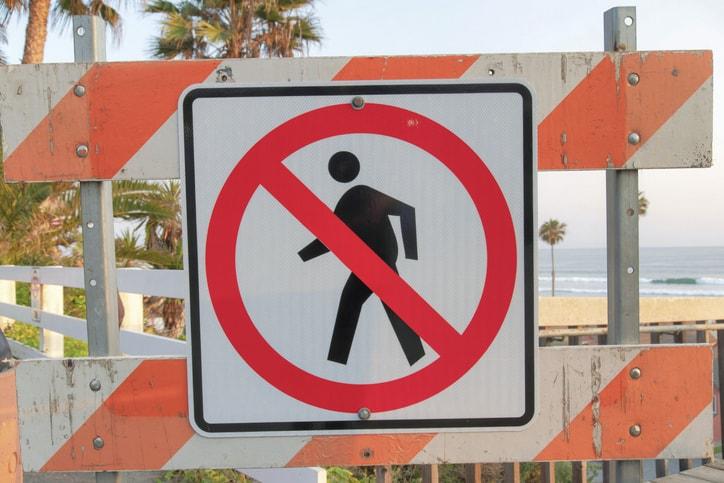

(844) - 444-4444

Under New York’s comparative-fault law, a pedestrian struck and hurt outside of a designated crosswalk may bear some of the blame for what happened and may receive less compensation than if injured while using the crosswalk. In other words, assuming that the driver also bears some fault, culpable conduct by the pedestrian may reduce, but not necessarily eliminate, that pedestrian’s recovery for pain and suffering.
The uneasy coexistence of pedestrians and motor-vehicle traffic goes back a long way.
According to the BBC, the word “jaywalking” was first used in December 1913, in Syracuse, where a department store Santa with a megaphone used the term in calling out pedestrians crossing the street anywhere they pleased.
The first widespread public use of the term, which simply meant inexperienced walker, was by Harper’s Magazine in 1915, according to The Gothamist. But the idea of holding jaywalkers legally accountable for their actions appears to have come from the auto industry, which grew alarmed by a citizens’ petition in Cincinnati to mechanically limit the speed of cars to 25 mph – a measure designed to protect pedestrians.
For a time in the early days of the American city, streets weren’t the presumed domain of cars and trucks but generally public spaces where activities that endangered or got in the way of people using them were frowned upon. In this climate, motorists had few rights, often were derided as “joy riders,” and found that owning a car didn’t do them much good.
So it was that early automakers, soon after beginning to mass-produce cars in the early 20th century, launched a campaign to appropriate the public spaces of cities for motor-vehicle traffic.
New York pedestrians have a number of rights and duties, which determine who has the right of way in particular scenarios. These rights and duties explain, for example, who has the right of way in crosswalks, on sidewalks, in areas other than sidewalks, among other scenarios. That term, “right of way,” means:
“The right of one vehicle or pedestrian to proceed in a lawful manner in preference to another vehicle or pedestrian approaching under such circumstances of direction, speed and proximity as to give rise to danger of collision unless one grants precedence to the other.”
The New York Vehicle and Traffic Law may contains provisions about who has the right of way in a particular situation, but just because some motorists may have the right of way does not mean that they can heedlessly or blindly drive on the roadway. All motorists must exercise reasonable care to see what is there to be seen and react accordingly.
Many accidents happen when pedestrians try to cross crosswalks. The legal definition of the term “crosswalk,” contained in Section 110 of the New York Vehicle and Traffic Law, can be somewhat difficult to digest:
“That part of a roadway at an intersection included within the connections of the lateral lines of the sidewalks on opposite sides of the highway between the curbs or, in the absence of curbs, between the edges on the traversable roadway.”
or
“Any portion of a roadway at an intersection or elsewhere distinctly indicated for pedestrian crossing by lines or other markings on the surface.”
In many cases, a crosswalk will entail an area “distinctly indicated for pedestrian crossing.” Pedestrians generally have the right of way within a crosswalk, but are also obligated to follow traffic-control signal indications, including those relating to the use of a crosswalk. Following the rules of the road has become more important as, generally speaking, walking or cycling on or near roads has become more dangerous. Today’s outsized SUVs and trucks are at least 50 percent more likely to kill pedestrians than smaller vehicles, according to data published in the journal Traffic Injury Prevention.
Pickup trucks have also grown. Many now have much taller hoods, bigger blind spots, and more unforgiving designs.
Today’s pickup trucks sometimes also have fewer safety features than other cars on the road, despite having bigger blind spots and longer distances to brake. They are more likely to lack automatic emergency-braking systems with pedestrian detection and blind-spot warnings, according to some reports.
Pedestrians have never had it easy.
A pedestrian strike or knock-over accident can result in significant, debilitating injuries that can lead to immense loss of enjoyment of life.
When a car, truck, or SUV does injure a pedestrian, the latter can have a case for damages even if partly to blame for what happened. New York’s comparative fault rule provides for compensation in proportion to fault. So, for example, if a judge or jury decides that the defendant driver is 80 percent at fault and the plaintiff pedestrian is 20 percent at fault, the latter can still recover 80 percent of damages.
A driver may be at fault for a pedestrian accident if he or she did not exercise reasonable care, which can include:
To establish negligence, an injured pedestrian must prove that the driver was negligent and such negligence was a legal and proximate cause of the injuries
If a pedestrian’s failure to follow the rules of the road played a part in causing an accident, the pedestrian likely would be found at least partly at fault provided that such failure to follow the rules of the road caused or contributed to the crash.
Besides jaywalking, other causes of pedestrian accidents can include:
The risk of a pedestrian accident increases after dark. If pedestrians plan on walking after dark, wearing light-colored or reflective clothing and carrying a flashlight may prove helpful.
If you are a hurt pedestrian, William Mattar, P.C., may be able to help. Our attorneys have helped thousands of injury victims who were injured by negligent drivers and are here to help injured pedestrians 24 hours a day. So, give us a call, at 844-444-4444, or fill out our free initial consultation form.





